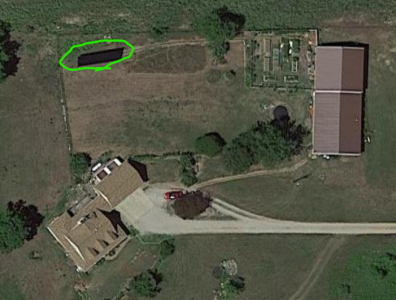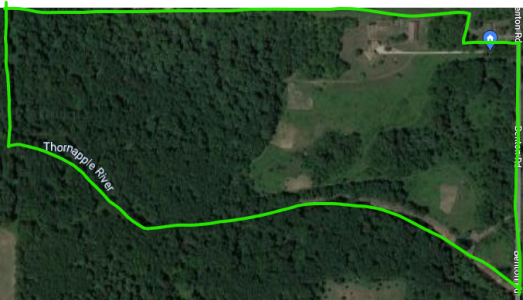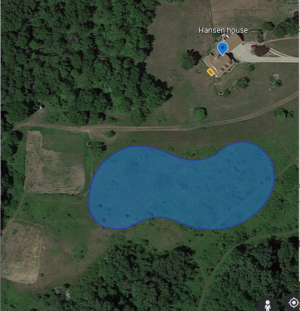- Joined
- Nov 23, 2014
- Messages
- 2,606
We went with a ground mount stuck in the back corner of the fenced in "dog/chicken" yard. Ours isn't the most efficient wiring-wise as we have some long runs. The panels (circled in green) have their DC line buried along the fence line (you can still see the dirt path), through my wife's garden to the corner of the pole barn. Then routed in conduit under the eaves to the invertor which is mounted on the outside of the barn (lower LH corner). Our main panel is in the barn with buried 150A service running to the house. The inverter back feeds the main panel at the barn. I questioned the placement of the inverter (outside) as it's right adjacent to my shop's service door, why not put it inside? Our Generac inverter is meant to be outside and needs to be accessible to the power company and/or fire department can shut it down as we're back-feeding the power lines.
Our batteries are in the house with an auto-transfer switch to energize a few circuits if the grid goes down. There's a DC and AC line running from the inverter to the house. That run is still visible in the photo (below the trees and next to the car parked next to the then open trench); runs from the inverter to the corner of the garage. Then in conduit under the eaves to the back of the house. The AC line runs to the transfer switch, DC runs to the batteries. If we're running off battery power, the batteries send DC from the house to the inverter at the barn. The inverter then sends AC either to the main box in the barn, or AC back through the transfer switch line in the case of a power outage. Probably close to 1000' of wiring to get the solar from the panels to the batteries and back to the house.
Our was a turn-key system installed by Pink Energy. I see "click-bait" for similar systems with (we generate 8400W and have 18 kWh battery backup) for around $20K. Those are typically roof-mount, I can't say if the structure for our ground-mount was more expensive or not as we didn't want the panels on our roof and never priced it that way. After our federal tax credit, we paid about $30K more than we could of if I'd have done the work myself. At my ancient age of 62 at the time, NO THANKS! It wasn't a lot of difficult work, but I chose to write a check as the crew of 10 or 12 guys kept pretty busy for two days putting in our system. Other "stuff" we got was replacement LED bulbs for every light in the house, and they topped off our blown-in ceiling insulation from the settled 8" thick back up to 14".
Bruce

Our batteries are in the house with an auto-transfer switch to energize a few circuits if the grid goes down. There's a DC and AC line running from the inverter to the house. That run is still visible in the photo (below the trees and next to the car parked next to the then open trench); runs from the inverter to the corner of the garage. Then in conduit under the eaves to the back of the house. The AC line runs to the transfer switch, DC runs to the batteries. If we're running off battery power, the batteries send DC from the house to the inverter at the barn. The inverter then sends AC either to the main box in the barn, or AC back through the transfer switch line in the case of a power outage. Probably close to 1000' of wiring to get the solar from the panels to the batteries and back to the house.
Our was a turn-key system installed by Pink Energy. I see "click-bait" for similar systems with (we generate 8400W and have 18 kWh battery backup) for around $20K. Those are typically roof-mount, I can't say if the structure for our ground-mount was more expensive or not as we didn't want the panels on our roof and never priced it that way. After our federal tax credit, we paid about $30K more than we could of if I'd have done the work myself. At my ancient age of 62 at the time, NO THANKS! It wasn't a lot of difficult work, but I chose to write a check as the crew of 10 or 12 guys kept pretty busy for two days putting in our system. Other "stuff" we got was replacement LED bulbs for every light in the house, and they topped off our blown-in ceiling insulation from the settled 8" thick back up to 14".
Bruce




